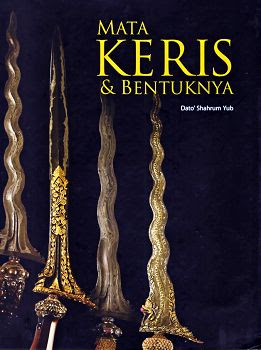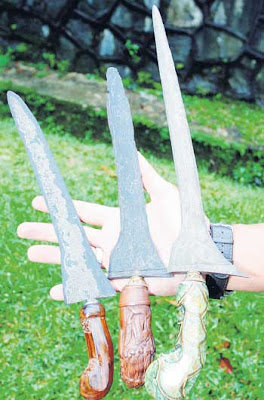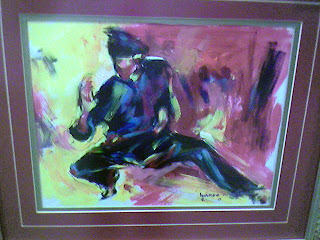It is a standard scene. The student has come here to study silat. He harbours a personal goal in wanting to be able to defend himself. It may be for revenge, for protection, for self-development or simply for recreation.
He sees the other students milling about, talking about things other than martial arts until one of them becomes aware of the teacher approaching. He is the first to stand at attention followed by the others.
The teacher says a few words and indicates the beginning of the class. The students salute the teacher, their friends and begin training. Here, the commonality of this scene fractures into three separate realities.
In one reality, the teacher asks one of his students to strike him in the chest. One obligingly does and is met with an evasion and a parry, a strike to the vitals, usually just indicated, followed up with a lock or takedown.
The teacher then repeats it a few more times, ensuring they remember what they see. Once he is satisfied, he tells them to copy his exact movements and apply them on their partners. End of scene one.
In a second reality, the teacher has prepared his student for months in the field. The work he does on the farm has given him proficiency in his physique.
When he executes the wardance, it is something neither master nor student has seen before. It comes naturally to him, and yet, each blossoming of the hands and prancing of the feet are calculated, as if reacting to an unseen enemy.
Every angle is in his control, every imbalance correctable, every muscle in its proper place, every beat of the accompanying rhythm matched note for note. His movements are both pleasing to the eye and intoxicating to the self. End of scene two.
In a third reality, the teacher sits in front of his student and clasps his right hand, or recites some verses into a glass of water, which he drinks, or pats the small of his back, or, or, or... Almost immediately, the student feels empowered, as if his sinews have been charged by a battery. He is pit against a senior student and they fight.
He defends successfully against all his senior's attacks and manages to beat him back and wins the round. He has never studied a martial art before. End of scene three.
Three foreign students who come to Malaysia with the specific intention of studying Silat Melayu may get a shock of their lives when they meet each other at the airport to compare notes on their way home.
Each of them has trained in a different system with different methods and has been indoctrinated with a different idea of what silat is. None of them can comprehend what the other is rambling about because the methods they studied make no sense. Is this a familiar problem?
Impression, Expression, Activation
The truth is that all three methods are considered standard practise by many Melayu martial artists in Malaysia. Ironically, because of the often exclusiveness of major Silat Melayu styles in Malaysia, not many pesilat are aware of alternative training methods. That is, alternative to their own.
Impression Method
The Impression Method (IM), which is technique or buah-based, relies heavily on the impression of the syllabus upon the mind and physique of the student.
This involves the creation of standardised blocks of movement with a set beginning and an end. The student begins with nothing and is taught to mimic and act out the blocks and eventually string them together.
The key characteristics of this system is the initial rigidity of the process, the stressing of reflex as against analytical thought and the belief that a particular block of movements (often termed technique) are a result of strenuous research and is the best possible answer to a particular incursion.
Although the term ‘buah’ is also used to describe any strikeform that makes contact with the opponent, even if it isn’t a reflex action but a result of strategic analysis, most modern Malaysian Silat styles subscribe to this impression method to achieve immediate results.
The advantages are numerous. It keeps the student’s attention focused upon the apparent physical goals of silat: that is learning how to fight. It creates a realistic setting in which the student learns: reacting off a partner who is simulating violence.
It also allows for minimal supervision of a large group: several instructors could monitor a group of hundreds. It allows for training of large numbers of students in a short span and it also produces immediate results: The student usually apply the technique drilled into him almost immediately.
Disadvantages of IM
Unfortunately, there are two sides to every coin. A fighting-focused student usually shies away from the more esoteric aspects of the art such as ethics, responsibility, philosophy, religion, etc. Only a small percentage actually do find themselves interested in such topics and even less finally adopt it as an integral part of their worldview.
Secondly, a realistic setting doesn’t necessarily mean real. A reflex-conditioned fighter may find himself dealing with situations that were not inherent in his training. Since his analytical mind has already been trained to take a back seat to his reflexes, he may survive by sheer effort, but will rarely escape unscathed.
Thirdly, large group training creates minor mistakes and bad habits that unless attended to personally by a trained instructor (and not mass-produced carbon copy yes-men), could result in the ineffectiveness of the technique when applied combatively, or worse, muscular and ligament injury that will lead to permanent damage.
Fourthly, strict IM style training often mentally cages a student and teaches him to think within the box and rarely outside of it. This cuts off important avenues of creative and lateral thinking in problem solving. In combat, life or death hangs in the balance.
IM arts have been very popular in Malaysia because of their apparent systematic pedagogical style and are quite well represented among the major silat styles. Silat Seni Gayong[1], Silat Cekak and Silat Lincah are some of the better examples. Each of them has encountered the setbacks of the Impression Method and have compensated for them in their own ways.
For example, in Silat Cekak, after the initial memorisation and drilling of the standardised buah to completion, students are taken through a Skill Set. Unusual and sneaky attack styles are introduced, of which no standard answer was provided for in the syllabus. Students are guided to analyse the tools provided in the memorised buah and apply them in their unique fashion to counter these new threats[2].
Expression Method
Next is the Expression Method (EM). Counter to IM, the Expression Method seeks to draw personal ability out of the student and makes his thinking a large part of the development process.
Instead of forcing him to accept indoctrination, he is guided through several stages of empowerment, namely physical (re)education, attitude orientation, affinity identification, skill development and practical application.
Because of the unpredictability and delicate psychological processes involved, it can sometimes take years or a matter of months before any noticeable change can be observed. This training method can also be described as experience-guided learning. It is the hallmark of many traditional martial arts and to be fair, traditional education.
A fictional scene reflects this training orientation. A student who had come to study from a silat master was told he had to perform physical duties around his master’s home. The reason is often and justifiably so, that if the master was to devote time to training him, his energies couldn’t be put to sustaining his livelihood.
However, tending to the garden or performing menial tasks served a double purpose. It was meant to educate the student in physical efficiency. Not only would he be taught to swing a hoe properly – using minimal strength and maximum leverage – to reduce long term physical damage and increase work efficiency, he would obviously receive superb physical conditioning.
Going to the gym always ends up with no productivity and glistening muscles, but farmwork got you that and potatoes as well.
Doing work would eventually bore the young student and once in a while, for displaying patience, kindness, diligence – and other good qualities that the master would have deliberately inculcated within him – he would be rewarded with a lesson of empowerment.
The master then identifies the student’s strength in a particular area and develops him towards mastering that end. If his coordination leans toward high fighting, his skills would be developed in that direction.
If he seems comfortable on the ground, then ground fighting and so on. However, the student wouldn’t be forced into any direction, simply given the opportunity to develop.
Finally, the student is given the opportunity to see for himself what he has achieved. He is tested not for what he has learned from his master, but for what he has discovered about himself.
Thus, confidence-breakers such as wrestling with wild animals, engaging full-fledged masters of rival schools, jumping into pits full of sharpened bamboo or being buried alive ensure that the student brings not his master with him to his tests, but that he has all the tools already at hand. He just had to discover them with a little help.
Silat & Karate Kid?
Two very interesting examples of this traditional method come to mind. The first was told to the author. A student who wished to study silat was given farmwork to carry out[3].
However, the master didn’t teach him anything but used to hit him in the back of the head. When asked why, he replied that it was his own fault for not being wary.
Soon after, the student was sensitive enough to his surroundings to sense his master’s approach. After several sad attempts, he finally discovered the most effective and least painful way to parry his blows.
When the master was satisfied, he began throwing stones, requiring the student to master evasions. And so on, and so on.
Eventually, he developed his own martial art, not from being taught, but from guided self-discovery. As they say, necessity IS the mother of creation.
Another example is, ironically, a scene from the first Karate Kid movie when Miyagi sensei (played by the late Pat Morita) had tasked his impatient student Daniel with waxing his cars and painting his fence.
Not realizing what Miyagi sensei was doing, Daniel did what he was told, but in order to make the process smoother, naturalised the tasks with as little muscle inhibition as possible.
He interacted with the curves on the cars and the grains on the fence, until the movements became second nature to him. Yet, they were not combat moves. That is, until Miyagi sensei decoded them for him.
That sudden discovery led to others and the method of trying without trying was made clear to him, as to many other students of the traditional martial arts.
Natural University
Naturally, the advantages include a complete education that shapes and coordinates both aspects of the mind and body. A deepened understanding of the physical and psychological self rids one of muscular and mental inhibition, which could prove disastrous in combat situations.
It makes the adherent a master of himself and a student of none and frees his mind from mental barriers. He thinks in three dimensions and automatically chooses the path of least resistance and most profit.
Most of the students who study this way have an affinity for the esoteric and live their lives by the philosophy that they have been taught/ discovered.
Because of the understanding of his abilities, he is not tied down to one style of fighting, but adapts to the threat, irrespective of whether it comes from man or beast. In silat, this was eventually coded into the form of tari, bunga or kembangan. These flowing forms which have been compared to kata in effect educate the player about himself.
The degree is in Self-Discovery. His core courses are physics, biology, chemistry, biomechanics, balance and percussion while his elective courses are attitude adjustment, psychology, neurolinguistic programming and so on. When he graduates, it is with the ability to control himself. And self-control facilitates the control of others.
EM in Senaman
Today, this method is rarely used in the major silat styles but exist primarily in small, rural silat groups and one on one sessions. However, a modern method is currently practiced in Silat Melayu Keris Lok 9 as founded by guru Azlan Ghanie.
The method, popularly known as Senaman Tua redefines silat tari and kembangan into static calisthenic exercises that seek to reeducate the physical culture of the human being[4].
Disadvantages of EM
Sadly, what was good for IM is not for EM. Training in this method could never produce a ready army on hand, nor can it create cohesion for lack of a solid common identity among students.
A student who is unaware of the process may even become bored, disenchanted and eventually leave his master for other 'greener' pastures. Because of the due attention a master has to provide, this also means groups larger than ten would be difficult to control or monitor.
Activation Method
The third method is the Activation Method (AM). Depending on who you speak to, this can be spiritual, supernatural or psychological in nature. However you want to label it, AM deals with the direct activation of hidden potential within the human being and can be carried out in a number of ways.
It begins with the assumption that every human being is imbued with innate potential for movement. They say, everyone is born with it.
Some call it Gerak (motion), Ibu Gerak (source of motion), Ibu Gayong (source of divine motion), al-Aql al-Awwal (the first mind), Barakah (divine gift), The First Principle, etc.
Whereas IM sought to mold the student to accept the art and EM sought to have the art developed by the student, AM simply bypasses the body and mind and goes straight to the soul and activates the ‘art’ from there.
Scientifically, there is no explanation. Some may try to wave it away as hypnosis, hoaxes or even plain delusion. Since this method is, at best, incredible, I shall proceed to only discuss those examples which have been documented.
In one instance, Ustaz Azam, the Khalifah Perang (War Caliph) of Persatuan Seni Silat Gayong Maarifat Malaysia claimed in an advertisement[5] that "By participating in this Gerak Laksamana course … the caliph/ caliph’s representative will open the door of your body’s ‘batin’ energy … in a short period you will be able to explore any form of silat … perform silat movements and master complex combat techniques".
The advert goes on to explain "It should be mentioned that this energy door is present in all human beings and all masters or practitioners of ilmu batin who are experts are able to open these batin doors within the human body".
"By mastering the knowledge of true internal energy which lies within the human being there is no need for requesting of assistance from jin[6] or other superstitious aspects".
Is the statement an oxymoron? Apparently, it isn’t for many Malaysians who took the advert in stride.
Another explanation is given by guru Abdul Karim Mat Shah[7] of Silat Semula Jadi (Natural Silat). According to him, silat (self-defence) is inherent knowledge in the self. It is present even in a baby who blinks when one attempts to touch his eyes.
The difference here lies is his attestation that training is a must. He stressed that without physical training, ‘natural’ motion cannot translate into movement. He describes the ‘natural’ motion akin to an electric shock.
"It’s like a flowing current… we can sense the enemy’s pulse (intent). We instinctively know his movement and can move anywhere (he goes)"."Silat Semula Jadi will only come to those who really want it to. It will seep into the body if it is really wanted. Within a month, it can be done, if it is really wanted," he repeats.
Islamic Activation?
However, these attempts at clarification often fog the issue and leave the devout Muslim scratching his head (not to mention the pronounced skeptics).
Ustaz Zainuddin Othman[8] of Silat Sendeng Nusantara, a religious teacher of sufistic background gives it a more Islamic spin.
In his explanation, he calls it Ibu Gayong."… in reality, Ibu Gayong is a secret of the soul that emanates from every human being, conferred by Allah to us, which is called reflective movement. In the sufi’s language, it is Al-‘Aql Al-Awwal, or the pure soul".
He gave the example of the Holy Prophet Muhammad PBUH who wrestled two Arab wrestling champions, Al Aswad and Rukanah, and won.
"How did he win, when he wasn’t even an expert in wrestling? Clearly, he had stepped forward to prove that subscription to Allah’s strength is far more powerful than depending on one’s own … therefore, defensive reflective motion arose from his submission to Allah".
A more graphic and practical display was described by Ustaz Wan Kamarulzaman Wan Abdul Aziz[9], founder of Persilatan Gerak Suci Mangkubumi. When he first made known his intention of studying a silat style named Silat Gerakan Suci, the master guru Wan Asri initiated him with some H2O.
"He gave me a glass of water and immediately, I could extrapolate movements. But my movements were too fast, they were uncontrollable. It came quickly, just as when we first learn to drive a car, just as uncontrollable. After you get your licence, then you’ve mastered it," he quipped.
According to Ustaz Wan, this ‘motion’ exists in all human beings. It only has to be ‘activated’ so that it may be used consciously. He gives the example of reflexive movements that occur during sleep.
"Motion in this silat is a result of our supplications (to Allah) and our spiritual practices … in other silat, the physical is taught first, such as buah, kuncian and such, but in Gerakan Suci, the ‘gerak’ method is given priority".
"Initially, when I began teaching, I also favoured the ‘gerak’ method … but I noticed it wasn’t appropriate. The emanated movements depend on the practitioner. If he has studied silat before, his movements are beautiful".
"But, for those with no silat basics … pandemonium. Some just start rolling around. The silat movements are just rubbish. No artistry whatsoever … that is why … I began teaching the physical aspect first".
It may surprise many to know even though the three methods (IM, EM and AM) seem different, but many perguruan of the former two also subscribe to the AM concept, albeit later, much later in the training.
Sometimes, this is because of the situation that Ustaz Wan faced early on in his teaching career, others because it is considered the highest secret of their perguruan.
Personally, I have only experienced examples of IM and EM but have yet to sample AM. It would make an interesting article should it ever happen. In any case, all three methods, and more besides, exist in all Silat Melayu to a certain degree or other.
To be able to determine the extent of subscription, surveys have to be done on a case by case basis, and because of the secrecy surrounding most of these practices/ beliefs, it mostly has to be done by participative observation.
Whatever method you chose to train in, you’ll almost always have an interesting tale to tell your mates back home, of pain, ecstasy or pandemonium.
_________________________________
[1] Sheikh Shamsuddin S. M. Salim, The Malay Art of Self Defence: Silat Seni Gayong, North Atlantic Books, 2005.
[2] PSSCUHM, Silat Cekak Hanafi: Peneraju Warisan Mutlak, Kuala Lumpur.
[3] Mohd Zainudin Ismail, 2001.
[4] Senaman Tua VCD Vol 1, 2003.
[5] SENI BELADIRI April 2000, p59.
[6] Jin or Djinn, an Arab word used to classify all non-corporeal creatures which are not from the Angelic Hierarchy in Islamic theology.
[7] SENI BELADIRI February 2001, p8.
[8] SENI BELADIRI September 2002, pp7 and 17.
[9] SENI BELADIRI August 2002, pp7, 28 and 29.

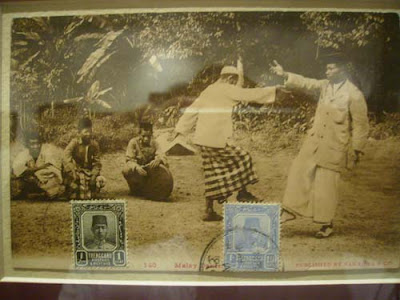 The postcard pictured above was taken from the Malaya: 500 Early Postcards exhibition currently being held in Badan Warisan Malaysia, No. 2 Jalan Stonor in Kuala Lumpur.
The postcard pictured above was taken from the Malaya: 500 Early Postcards exhibition currently being held in Badan Warisan Malaysia, No. 2 Jalan Stonor in Kuala Lumpur.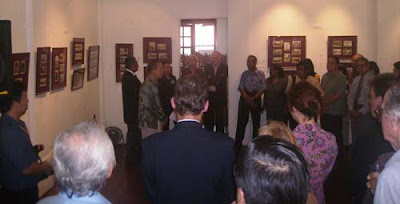




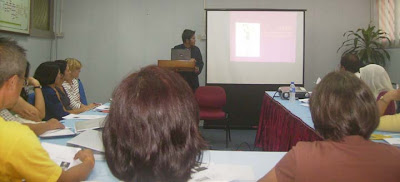 It's been awhile since I've been to the National Museum, but this visit was fun. Added to that is a discovery I made while surfing online today. I found this book on sale at the National Museums Department website, but was lacking information on its availability. It costs RM110 (softcover) and RM150 (hardcover). Definitely next on my list of must gets. Unless someone wants to buy it for me?
It's been awhile since I've been to the National Museum, but this visit was fun. Added to that is a discovery I made while surfing online today. I found this book on sale at the National Museums Department website, but was lacking information on its availability. It costs RM110 (softcover) and RM150 (hardcover). Definitely next on my list of must gets. Unless someone wants to buy it for me?
